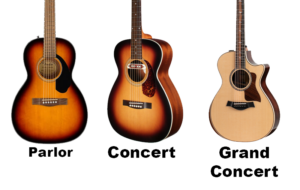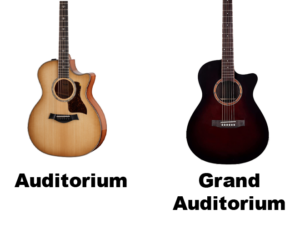Uncategorized
Rock On with the A5 Chord Guitar: Unleash Power and Energy
Hello, fellow guitar enthusiasts and music lovers! Are you ready to dive into the electrifying world of the A5 chord guitar? Today, we’re delving into the realm of rock and power chords as we explore the mighty A5 chord – a driving force that adds raw energy and excitement to your playing. Whether you’re a budding guitarist ready to ignite the stage or a curious soul eager to understand the foundation of rock music, this guide will introduce you to the dynamic universe of the “A5 Chord Guitar.” So, pick up your guitar, plug in, and let’s embark on a journey filled with sonic power and musical intensity!
Unleashing the A5 Chord Guitar: The Essence of Power Chords
Think of the A5 chord as a musical powerhouse that forms the backbone of many rock and alternative tunes. This chord’s simplicity and raw intensity create an undeniable sense of power and drive, making it a quintessential element of rock music. Just like a lightning bolt on a stormy night, the A5 chord strikes with energy and sets the stage for electrifying performances.
Mastering the A5 Chord Guitar: Crafting Sonic Thunder
Let’s dive into the mechanics of forming the A5 chord on your guitar. Follow these steps:
1. Finger Placement: Begin by placing your index finger on the 2nd fret of the D string (the fourth thickest string), marking the root note (A).
2. Ring Finger: Position your ring finger on the 2nd fret of the G string (the third thickest string), forming the perfect fifth (E).
3. Strumming: Focus on strumming the A and D strings (the fourth and fifth thickest strings) while avoiding the low E string (the thickest string). You can also strum all three strings (A, D, and G) for a fuller sound.
4. Sound Check: Strum the strings individually to ensure each note rings out clearly. Adjust finger placement if needed for a powerful sound.
Exploring A5 Chord Guitar Variations: Adding Depth
While the A5 chord is inherently simple, you can add variations to enhance its sonic palette. Here are a couple of ways to experiment:
1. Add Distortion: Plug into an amplifier and apply distortion for a gritty and edgy sound that’s characteristic of rock music.
2. Palm Muting: Experiment with palm muting by resting the edge of your hand lightly on the strings near the bridge. This technique adds a percussive and rhythmic quality to your A5 chord progressions.
The A5 Chord Guitar in Action: Rock Anthems
The A5 chord’s raw power has fueled countless rock anthems. Here are a few iconic songs that showcase the might of the A5 chord:
1. “Smoke on the Water” by Deep Purple: The legendary riff that kicks off this classic tune is built around the A5 chord, creating an instantly recognizable and unforgettable sound.
2. “Blitzkrieg Bop” by Ramones: The driving force behind the punk rock revolution, the A5 chord propels the energetic and rebellious spirit of this timeless track.
Tips for Mastering the A5 Chord Guitar
As you dive into the world of the A5 chord, consider these tips to enhance your playing:
1. Focus on Precision: Strive for clean and precise strumming to ensure each note rings out clearly.
2. Experiment with Rhythm: Vary your strumming patterns to add rhythmic interest and dynamic flair to your A5 chord progressions.
3. Combine with Other Chords: Mix the A5 chord with other power chords or open chords to create dynamic chord progressions.
Conclusion: Embrace the Power of the A5 Chord Guitar
Congratulations, you’ve embarked on a thrilling journey through the electrifying realm of the A5 chord guitar. As you unleash power chords, experiment with variations, and rock out to iconic tunes, you’ll discover the A5 chord’s ability to captivate audiences and infuse your music with raw energy. Keep practicing, keep experimenting, and keep embracing the captivating allure of the A5 chord. It’s your gateway to a world of musical intensity, where each strum reverberates with sonic thunder. So, plug in, turn up the volume, and let the invigorating world of the A5 chord guitar propel you into a realm of melodies that ignite the soul and ignite the stage, one powerful chord at a time!
Uncategorized
Acoustic Guitar Sizes: Finding Your Perfect Fit
Have you ever wondered how the size of an acoustic guitar affects its sound? From the intimate, focused tones of a parlor guitar to the deep, resonant sound of a jumbo, the size and shape of an acoustic guitar can have a profound impact on its sonic characteristics.”
In this article, we’ll explore acoustic guitar sizes, their variations, and how to choose the perfect size that suits your needs.
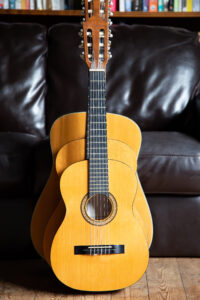 Understanding Acoustic Guitar Sizes: A Musical Puzzle
Understanding Acoustic Guitar Sizes: A Musical Puzzle
Acoustic guitar sizes refer to the dimensions and proportions of the guitar body, which significantly influence the instrument’s tonal characteristics, projection, and playability.
Just like pieces of a musical puzzle, different sizes create distinct voices that cater to various playing styles and preferences.
The Spectrum of Acoustic Guitar Sizes
Acoustic guitars come in several sizes, each with its unique qualities and attributes. Let’s explore some common acoustic guitar sizes and their defining features:
-
-
Parlor Guitar: The parlor guitar is petite and charming, making it an ideal companion for intimate settings.
The name comes from the rooms in which the guitar was typically played in the late 19th century.
Some famous musicians who have been known to use the parlor guitar are, Eric Clapton, Mark Orton, Ed Sheehan, and John Mayer
Its smaller size results in a focused and balanced sound, perfect for fingerpicking and folk music.
-
Concert Guitar: Slightly larger than the parlor guitar, the concert guitar offers enhanced projection and volume. It strikes a balance between portability and sound, making it versatile for various genres.
It is often used in classical music and flamenco music with its full sound.
-
Grand Concert Guitar: With a larger body than the concert guitar, the grand concert guitar boasts a fuller sound and improved tonal complexity.
A popular choice for those who have a smaller stature and require an instrument that’s built to a shorter scale. Great choice for traveling musicians who often play live performances.
It’s suitable for fingerstyle playing and intricate arrangements.
-
Auditorium Guitar: The auditorium guitar, also known as the orchestra model (OM), features a well-rounded sound with a pronounced midrange.
More shallower than the dreadnought and narrower in width than a concert guitar. An Auditorium guitar brings the body closer to the player, making it feel more intimate and comfortable for stage use.
Some famous musicians who play it include Ed Sheeran, John Mayer, and Eric Clapton.
-
Grand Auditorium Guitar: Expanding on the auditorium guitar’s design, the grand auditorium guitar offers a versatile sound profile with enhanced bass response and overall volume.
It is a versatile mid-sized guitar that is a good choice for those who want a single guitar to travel with. The tone is great for strumming and picking. It performs well on stage and in the studio.
It suits a wide range of musical genres.
-
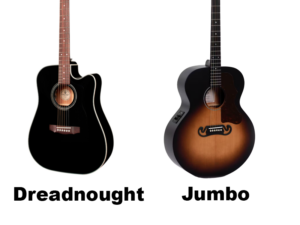 Dreadnought Guitar: The Dreadnought is a true icon, known for its bold and powerful sound. Its large body produces a strong bass response, making it ideal for strumming and vocal accompaniment.
Dreadnought Guitar: The Dreadnought is a true icon, known for its bold and powerful sound. Its large body produces a strong bass response, making it ideal for strumming and vocal accompaniment.This guitar is known for its powerful voice and lower-mid-rich tones that make it a favored choice for country artists. Although it is a popular choice for musicians of all genres.
Some famous musicians who play the dreadnought guitar include Hank Williams Jr, Elvis Presley, Keith Richards, Thom Yorke, and Kurt Cobain.
The original dreadnought guitars were made for the Oliver Ditson Company and featured mahogany backs and sides and spruce tops.
-
Jumbo Guitar: The jumbo guitar lives up to its name with a massive body that delivers robust volume and a deep bass presence.
This is the largest of the guitar family with a deeper body than the popular dreadnought. The body is wider and deeper than traditional acoustic guitars, which gives them a unique appearance.
Jumbo’s are well suited to rhythm guitarists in country and folk rock, and produce a deep rich sound favored by heavy strummers. Some famous musicians who play this guitar are Elvis Presley, George Harrison of the Beatles, Neil Young, Sheryl Crow, and Pete Townshend of The Who.
Choosing the Right Acoustic Guitar Size for You
Selecting the right acoustic guitar size involves considering factors such as playing style, comfort, and tonal preferences. Here are some steps to guide you on your quest:
-
Identify Your Playing Style: Determine whether you lean towards fingerpicking, strumming, or a mix of both. Different sizes excel in different playing styles, so choose one that complements your technique.
-
Consider Body Comfort: Hold and play guitars of various sizes to assess comfort. A guitar that fits well against your body ensures a pleasant playing experience, especially during extended sessions.
-
Evaluate Sound Preferences: Listen to the sound produced by different acoustic guitar sizes. Pay attention to tonal qualities, such as warmth, brightness, and projection, to find the one that resonates with your musical taste.
The Influence of Acoustic Guitar Sizes on Music
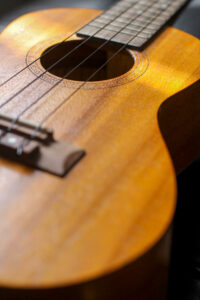 Acoustic guitar sizes and shapes can have a significant impact on the sound of the instrument.
Acoustic guitar sizes and shapes can have a significant impact on the sound of the instrument.The size of the guitar body type also relates to the volume of air within the instrument. Changes to the air capacity of the body will emphasize specific frequencies. A smaller body will have a more focused sound centered on higher frequencies, while a larger body will produce deeper low-end frequencies.
Body dimensions can provide some indication of the tone you might expect, but other factors exert a profound influence, too. Much depends on the tonewoods used to construct the body and the shape, size, and layout of the braces.
Finding Harmony in Acoustic Guitar Sizes
By delving into the nuances of size, sound, and playability, you’ve gained insights that will guide you toward the perfect fit for your musical aspirations.
As you continue your exploration, remember that each acoustic guitar size has its own unique voice and character. Embrace the joy of trying different sizes, celebrate the nuances of their sounds, and let your heart lead you to the one that resonates with your musical soul.
-
Uncategorized
Unlocking the Alluring AB Chord: A Beginner’s Guide
Embarking on a musical journey with the guitar is like stepping into a world of melodies, rhythms, and harmonies. As a beginner, learning the ropes of guitar playing includes discovering a variety of chords that shape the foundation of your musical skills. Among these, the AB chord, also known as the A flat chord, holds a special place. In this article, we’ll unravel the mysteries of the AB chord, explore its formation, provide practical finger-placement tips, and delve into its role in creating beautiful music. Get ready to dive into the enchanting realm of the AB chord and elevate your guitar-playing prowess!
Unveiling the AB Chord
The AB chord, also written as A♭ chord, is a unique blend of notes that adds a touch of intrigue and depth to your chord progressions. This chord consists of three notes: A♭, C, and E♭. The AB chord introduces you to the world of flat notes (♭), enhancing your understanding of musical theory and the diverse palette of sounds you can create on the guitar.
Fingering the AB Chord
Follow these simple steps to master the AB chord:
1. Position Your Fingers: Begin by placing your index finger on the 1st fret of the G string (third from the top). Next, use your middle finger to press down on the 2nd fret of the D string (fourth from the top), and your ring finger on the 3rd fret of the B string (second from the top).
2. Strum the Chord: Strum from the A string (second thickest) to the high E string (thinnest), ensuring that each string produces a clear, resonant sound.
Press your fingers down firmly on the strings and avoid touching the neighboring strings to prevent any unwanted buzzing or muting.
Benefits of the AB Chord
Learning the AB chord offers several benefits for beginner guitarists:
1. Unique Sound: The AB chord’s distinct tonal quality adds depth and character to your playing, making it a valuable addition to your chord repertoire.
2. Chord Progression Versatility: Incorporating the AB chord into your progressions allows you to explore a wide range of musical styles and create interesting chord transitions.
3. Ear Training: Familiarizing yourself with the unique sound of the AB chord sharpens your musical ear, enhancing your ability to recognize different chord qualities.
Practical Tips for Mastering the AB Chord
Here are some practical tips to help you perfect the AB chord:
1. Begin Slowly: Start by forming the AB chord shape slowly and ensure each string rings out clearly. Pay attention to your finger placement and apply gentle pressure to the frets.
2. Finger Placement Practice: Spend time placing each finger on the frets individually before forming the full chord shape. This builds muscle memory and finger strength.
3. Chord Transitions: Practice moving between the AB chord and other chords you know. This will improve your ability to switch chords seamlessly during songs.
Famous Songs Featuring the AB Chord
The AB chord’s unique sound can be found in various well-known songs across genres. Here are a few examples:
1. “Let It Be” by The Beatles: The AB chord contributes to the song’s serene and contemplative atmosphere, enhancing its iconic chord progression.
2. “Someone Like You” by Adele: The AB chord’s melancholic quality complements the song’s emotional lyrics and adds depth to its chord sequence.
3. “Boulevard of Broken Dreams” by Green Day: The AB chord’s somber tone suits the reflective and introspective mood of the song’s chord progression.
Conclusion
Congratulations, you’ve unlocked the captivating world of the AB chord! By mastering this chord shape, you’ve gained a versatile tool that can enhance your guitar playing and add a touch of intrigue to your musical creations. Whether you’re strumming along to your favorite songs, composing your melodies, or experimenting with chord progressions, the AB chord enriches your musical palette.
As you continue your guitar-playing journey, remember that practice and dedication are key to mastering any new chord. Don’t be discouraged by any initial challenges you encounter. With consistent effort and a passion for learning, you’ll find yourself transitioning smoothly between chords and creating captivating music that resonates with your unique style.
The AB chord is just the beginning of your musical exploration. As you delve deeper into the world of guitar playing, you’ll encounter a variety of chords, techniques, and melodies that will enhance your musical experience. So, keep strumming, keep learning, and most importantly, keep enjoying the wonderful journey of creating music with your guitar. Happy playing!
Uncategorized
Unlocking the Musical Mystery: What Key Is a Guitar In?
Have you ever found yourself mesmerized by the captivating sounds of a guitar, wondering about the secrets it holds? One intriguing question that often arises in the world of music is, “What key is a guitar in?” It’s a question that unveils a world of musical exploration and understanding. In this article, we’ll embark on a melodic journey to demystify the concept of key in music, explore its significance for guitarists, and equip you with the knowledge to unlock the harmonious magic of your six-stringed companion. So, let’s dive into the realm of musical keys and uncover the melodies they hold within the strings of a guitar.
Decoding the Musical Puzzle: Understanding Keys
At the heart of music theory lies the concept of keys, which serve as the foundation for creating melodies and harmonies that resonate with our ears and emotions. A key is like a musical home base, a set of notes and chords that work together harmoniously to create a specific tonal center.
The Role of Keys in Guitar Playing
For guitarists, understanding the key of a song or a piece of music is essential for several reasons:
1. Chord Progressions: Knowing the key allows you to identify and play the chords that naturally belong to that key. This knowledge empowers you to create pleasing and harmonious chord progressions that complement the melody.
2. Soloing and Improvisation: When it comes to soloing and improvisation, knowing the key is a game-changer. It guides you in choosing the right scales and notes that will harmonize with the backing chords, allowing you to create expressive and melodious solos.
3. Transposition: If you want to adapt a song to a different key to suit your vocal range or preferences, understanding keys helps you smoothly transpose the chords and melodies without losing the essence of the music.
Cracking the Key Code for Guitarists
So, how do you determine what key a guitar is in? Here are some steps to crack the key code and unlock the musical mystery:
1. Identify the Chords: Begin by identifying the chords used in the song or piece you’re playing. Pay attention to the major and minor chords that make up the progression.
2. Tonal Center: Look for the chord that feels like “home” or provides a sense of resolution. This chord is likely to be the tonic chord, which indicates the key.
3. Key Signatures: Key signatures are visual cues that help determine the key of a song. Pay attention to the sharps or flats in the key signature, which provide valuable clues.
The Musical Adventure of Keys on Guitar
Congratulations, you’ve embarked on a musical adventure to uncover the question, “What key is a guitar in?” By unraveling the concept of keys, understanding their significance for guitarists, and learning how to identify keys in music, you’ve gained insights that will elevate your guitar playing and allow you to navigate the harmonic landscape with confidence.
As you continue your journey with your guitar, remember that keys are the magical codes that unlock melodies, emotions, and creativity. Each strum, chord, and note resonates within the framework of a key, weaving a musical tapestry that captures the essence of your expression. So, pick up your guitar, let your fingers explore the strings, and allow the harmonious melodies of different keys to guide your musical exploration. Happy playing and key discovery!
-
advanced9 years ago
How to Play “Sleepwalk” on the 3-String Guitar! Guitar TABs Included!
-
beginner8 years ago
3-String or 4-String? How to Decide Which is Right for You!
-
beginner9 months ago
Exploring Different Guitar Types: A Beginner’s Guide
-
Blues Guitar8 years ago
Go-To Tunings for Blues Slide Guitar
-
advanced9 months ago
Fun and Effective Guitar Exercises: Elevate Your Playing with These 5 Simple Techniques
-
Uncategorized9 months ago
Acoustic Guitar Sizes: Finding Your Perfect Fit
-
Blues Guitar7 years ago
Jack Daniel’s Whiskey Barrel Guitar: How It’s Made and What it Sounds Like
-
Guitars9 months ago
Bass vs Guitar: Exploring the Musical Journey

